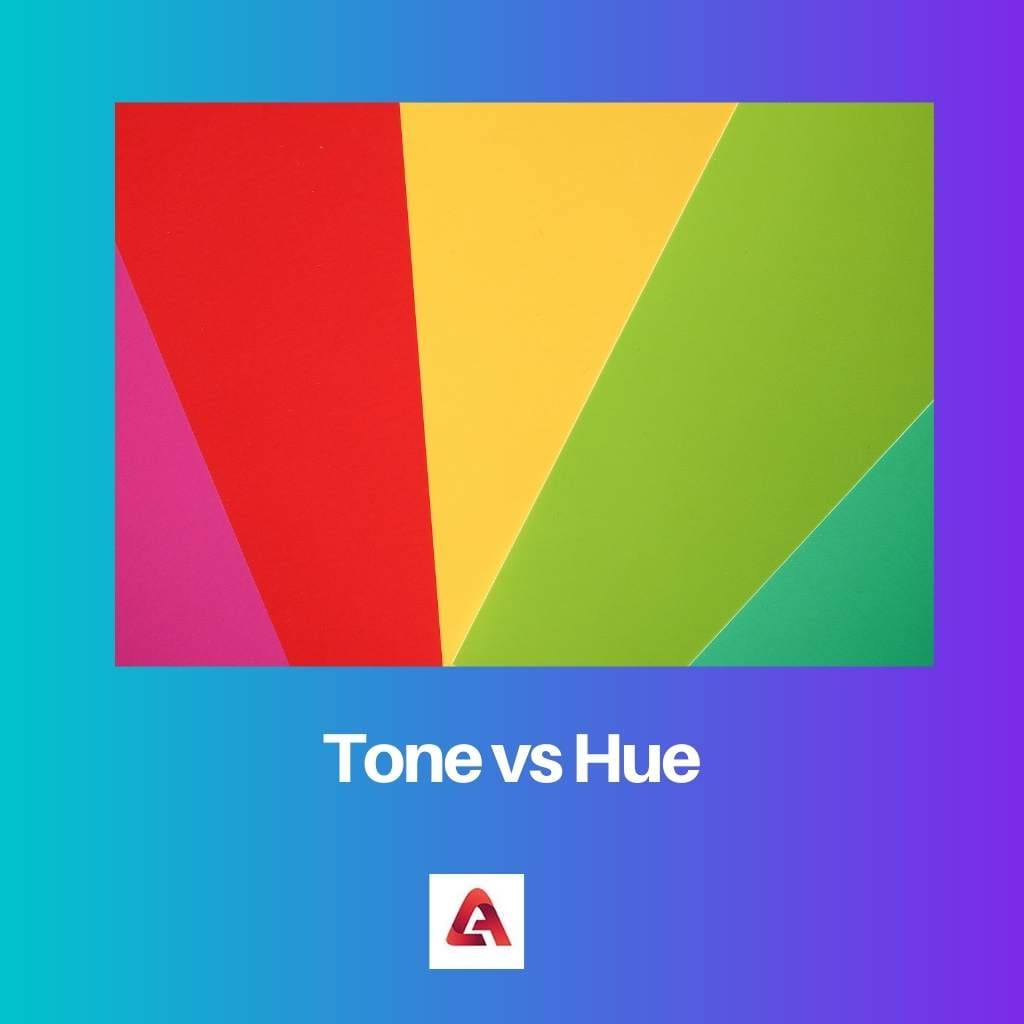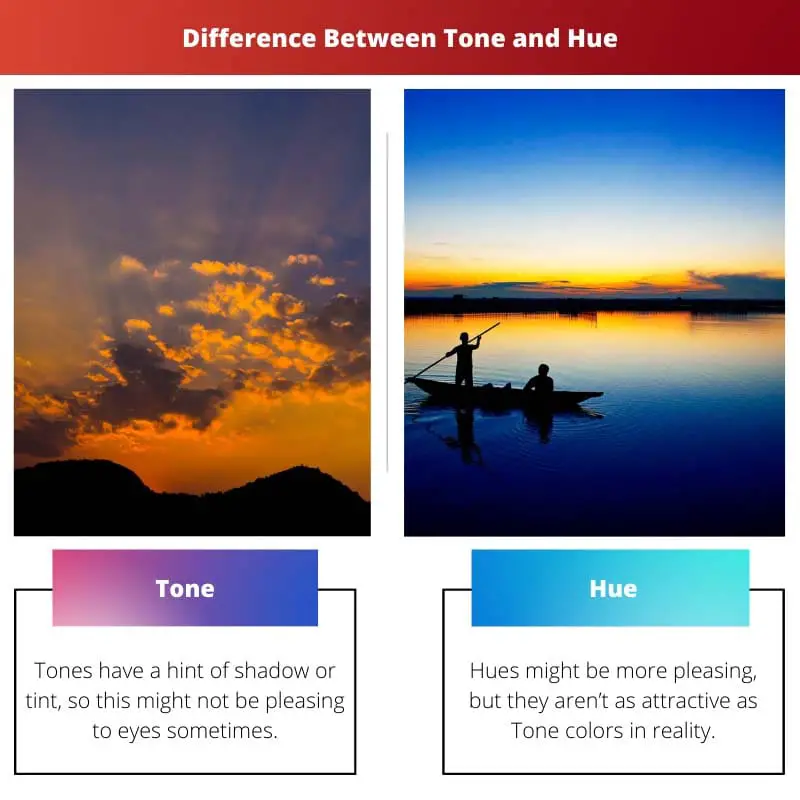The term “Hue” is miscalculated and considered a color. Similar is the case with Tint, Tones, and Shades. Color terminology includes words like tone and hue.
The tastes of tone and hue are different. Tone and hues are considered when decorating houses, painting, or purchasing rubies or stones.
Key Takeaways
- Hue refers to the actual color of an object, while tone refers to the lightness or darkness of a color.
- Hue is an attribute of the color wheel, while tone results from adding black or white to a hue.
- Changing the tone of a color can create different shades and tints while changing the hue creates a completely different color.
Tone vs Hue
Tone refers to the shade of color which can be changed by adding black or white color. Changing tone can create the effect of lightness or darkness, but it does not change the color of an object. Hue is the real color of any substance; changing hue means changing the entire color of an object.

A tone is any hue or combination of pure dyes with only grey applied. One should also be aware that grey is entirely neutral in this sense, meaning that it contains no colors other than white and black. If the grey is light or dark, soft grey will minimize the strength of a color.
With Philipp Otto Runge’s color sphere, the notion of a color scheme with a hue was discussed as early as 1830. The Munsell color system, developed in the 1930s, was a significant step forward because it recognized that visual uniformity precludes the color space from being a sphere.
Comparison Table
| Parameters of Comparison | Tone | Hue |
|---|---|---|
| Spectrum of Colors | Tone doesn’t form any spectrum of colors like Hue. | Unlike tone, it does form a wide range of spectrum of colors. |
| Pleasing in Nature | As opposed to Hues, Tones have a hint of shadow or tint, so this might not be pleasing to eyes sometimes. | Hues might be more pleasing, but they aren’t as attractive as Tone colors in reality. |
| Color Differences | Tones seem to be either mild or dark in color that is not the same as hues. | Hues are colors that can be differentiated from one another, such as orange from red or green by blue. |
| Boldness in Color | Discreet, nuanced, and sophisticated hues are examples of tones. | Hues are thought to be very bold, entertaining, and optimistic in terms of colors. |
| Form of Color | The tone is a bit of a mixed bag. Tone colors can be created by combining white and black colors with many other colors. | Hue seems to be the gentlest type of color. |
What is Tone?
Grey is added to a hue to create tones. A flat grey, which is made up entirely of black and white, can dissipate any color. One can use various quantities of black and white to blend the grey.
A greater amount of white can result in a thinner grey and, as a result, a lighter tone when added to the hue. When more black is used to make a darker grey, the result is a darker tone when combined with the hue.
Usually, plain grey is applied to a tone, which would be a hue or combination of pure colors. When one adds grey to a color, it makes it so much messier.
If one adds so much grey to a color, it will become over-dulled, and it will be almost impossible to recover the brilliance. Let’s bring some color back in and return to the Amethyst we described earlier.
Amethyst is a purple type of Quartz that is transparent if it does not have a tone. We name it Rose Quartz if it has a faint tone. It turns into a lovely Amethyst with around a ten percent increase in tone.
We’ll then be gazing at very attractive Uruguayan or Zambian Amethyst if we add another 10% tone.

What is Hue?
The term ‘hue’ refers to a gemstone’s color instead of the conventional term ‘color.’ On a technical and gemological basis, red, orange, purple, and many other colors we studied in school are called hues.
Most hues can be created without using black or white by varying the proportions of the 3 main colors of red, yellow, and blue. Dark red-orange and bluish-green-blue are two examples of hues that can be achieved this way.
The root of the colors we see is referred to as hue. Hues include direct and indirect colors that are yellow, red, green, violet, blue, and orange; however, tertiary colors (mixed colors with no dominant color) are also called hues.
The root of the colors we see is referred to as hue. Hues include direct and indirect colors that are (yellow, red, green, violet, blue, and orange); however, tertiary colors (mixed colors with no dominant color) are also called hues.

Main Differences Between Tone and Hue
- Tone, unlike Hue, does not shape a color spectrum. Hue, on the other hand, unlike tone, does shape a broad spectrum of colors.
- Tones, as compared to Hues, have a touch of shadow or tint, which may not always be appealing to the eyes. Hues can be more appealing, but they aren’t as appealing as Tone colors in real life.
- Tones, which are not the same as hues, appear to be either moderate or dark in color. Hues are shades that can be distinguished from one another, for example, orange from red or green from blue.
- Tones include subtle, complex, and elegant hues. Hues, on the other hand, are thought to be very bold, engaging, and cheerful in terms of color.
- The tone is a bit of a mishmash. Tone colors can be made by mixing white and black with a variety of other colors. Hue seems to be the gentlest hue.

- https://journals.sagepub.com/doi/abs/10.2466/pms.1971.33.3f.1327
- https://onlinelibrary.wiley.com/doi/abs/10.1002/col.20717

The concept of tone and hue in the context of color perception is fascinating. The comparison table provides a clear understanding of their differences.
I agree, John Reynolds. The visual comparison of tone and hue characteristics is quite enlightening.
Absolutely, John Reynolds. The comparison table is an excellent resource for understanding the nuances between tones and hues.
The section on creating tones by adding grey to a hue is very informative. The example of Amethyst and how its tone changes showcases the practical implications of tonal variations.
Absolutely, Murphy Karl. The practical demonstration of tonal changes provides a clear understanding of the concept.
Yes, Murphy Karl. It’s fascinating to see how the addition of a tone can transform the appearance of gemstones.
The detailed explanation of how hues are formed and their relation to the color wheel is very enlightening. It enhances the understanding of color theory principles.
Indeed, Jack25. Understanding hues as they relate to the color wheel is essential in comprehensive color theory.
The explanations provided for differentiating tone from hue are detailed and insightful. It’s important to understand these distinctions in the field of art and color theory.
I completely agree, Hunt Mike. The details about tones and hues are significant across different domains.
Absolutely, Hunt Mike. These distinctions are essential in various creative and scientific disciplines.
The practical demonstration of tone and hue manipulation in the context of gemstones is particularly enlightening. It showcases how color properties can be transformed in real-world applications.
Absolutely, Crobertson. The practical examples provide a deeper understanding of color concepts.
The detailed comparison table is very helpful in understanding the differences between tone and hue.
Absolutely, Robinson Rowena. Having a clear understanding of the parameters involved in tone and hue can provide a better perspective.
The information about how tones and hues are formed and impact color perception is fascinating. It’s remarkable how they contribute to the overall appearance of colors.
It’s intriguing indeed, Cameron10. The scientific principles behind color perception and manipulation are truly fascinating.
Definitely, Cameron10. Understanding how color properties are manipulated by tones and hues is intriguing.
The detailed explanation of what hue refers to is very insightful. Understanding its connection to gemstones adds an extra layer of interest to the topic.
Absolutely, Sgreen. The information about gemstones and hues is quite intriguing.
Indeed, Sgreen. Examining hues in gemstones provides a unique perspective on color classification.
The information about creating tones by adding grey to a hue is fascinating. The practical examples of Amethyst and gemstones provide a clear understanding of these color properties.
Indeed, Ellie Scott. The practical applications of tonal variations in gemstones are very intriguing.
I agree, Ellie Scott. The practical examples of tone manipulation are truly captivating.
The explanation on the difference between tone and hue is comprehensive and enlightening. It is crucial to understand these terms when dealing with color in any context.
You’re absolutely right, Candice00. The nuances in the descriptions are important to understand in color theory.